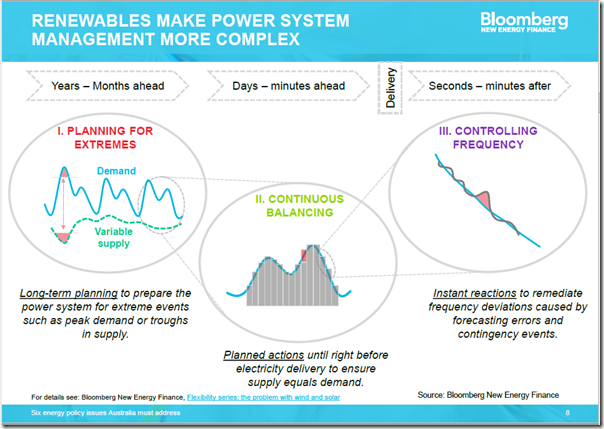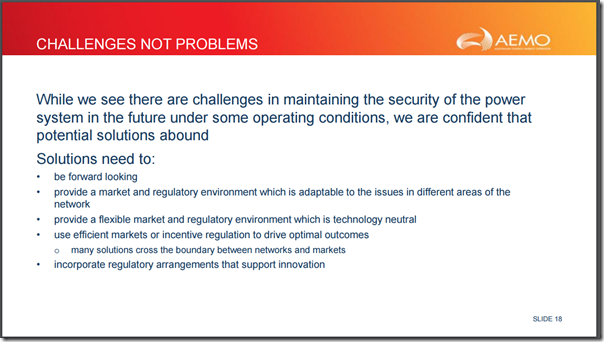In between other jobs, I’ve been working my way through all the slides that the Clean Energy Council has published on behalf of the speakers at the Clean Energy Summit (which I’d noted before I was going to attend).
One of the challenges in events like this is (given the multi-stream approach) in picking the right session to attend, and then to give the speaker my full attention.
1) I did attend part of the “Market Trends and Outlook” session, but for some reason a particular slide from Kobad Bhavnagri of BNEF (Bloomberg New Energy Finance) did not resonate with me at the time, but has now on review.
2) Unfortunately it seems that this was also the case with other media commentators (both the “new” ones and the “old” ones as well) at the event, as I did not see any commentary about it. This is a shame because (in my view) it sums up the challenges inherent in the transition towards more independently variable (and only partially controllable) forms of supply options – namely solar PV, wind (and also battery storage).
Given the high level of interest in today’s COAG Energy Minister’s meeting in Canberra, I have (with the permission of Kobad) included this here for your reference:
Particularly relevant (in my view) are:
Key point #1) The note that power system management is becoming more complex
It stands to reason that this increasing complexity, which we’ve not had to grapple with before in our more “simple” past, brings with it new challenges. This is what I have been trying to explain (perhaps not as well?) in a number of recent posts here on WattClarity.
Key point #2) That this complexity applies over a number of different time-scales.
This is an important point which sometimes seems to be missed, or forgotten, in the various discussions underway about this energy transition – for instance, someone might be thinking in the “years-months ahead” (planning) horizon when speaking, but the listener is thinking in the “days – minutes ahead” (dispatch) horizon, meaning that the messages become confused and the conversation sub-optimal.
For those who are BNEF subscribers, here’s the link that Kobad’s slide references – to their publication “Flexibility Series – the problem with wind and solar”.
Also worth noting from the same session is the slide here from David Swift from the AEMO that nicely follows Kobad’s segue above:
With respect to this slide, I would like to draw out two points (stressing that this is my interpretation, not the AEMO’s):
Key point #1) AEMO has noted that there are challenges, not problems:
With any contentious issue (such as what we are facing at several levels in this energy transition) choice of language, unfortunately, takes on a heightened importance – which is why AEMO has stressed that there are not “problems” (with the possible inference being that they are insurmountable), but that they are challenges. Indeed, some see them as big opportunities.
This is the point I’ve strived to make to those at the right-end of the Emotion-o-meter.
Also today I noted that Tristan Edis has commented over here about the use of the word “crisis” (another loaded term). Whilst it may not be a crisis:
(a) It’s certainly proved very painful for a number of different stakeholders affected in different ways – such as through escalated spot prices, and also through escalating forward contract prices;
(b) As others have noted, it is a reminder that more detailed planning is required than has been the case in the past.
Key point #2) That tackling these challenges is still a work-in-progress.
The AEMO has noted that there will be solutions found (and implemented) to tackle these challenges – but a key point here is that they are not yet found, or implemented. The challenges are not solved, but are solvable.
There’s a high volume of discussion currently focused on potential solutions to these challenges (or, even further upstream, trying to clearly understand and describe the challenges). Unfortunately these discussions seem to be:
(a) Perhaps used, by a subset of people towards the right of the Emotion-o-meter, as guise for more general resistance to change; but also
(b) Misconstrued by others (perhaps also deliberately, by a subset) at the left-end of the Emotion-o-meter who label all those involved in the conversation as “being hostage to fossil fuel interests” etc… (whereas reality is not just black and white). My sense is that this simplistic view is where the rhetoric arises about the need to “break the NEM” etc.
Given BNEF is often quoted by many at the progressive end of the energy transition, Kobad’s slide particularly resonated with me – though it was an opportunity foregone that it was not more widely communicated. Perhaps this post will help?




I guess something worth not skirting around is the fact that challenges will be presented as insurmountable, catastrophic and civilisation-ending by a range of parties keen to ensure that decarbonisation does not occur.
In that context, it becomes extremely important to channel the inspirational and genuinely wonderful spirit of engineering and science, which is legitimately technology neutral and looks to correctly diagnose and remedy these quirks in a fairly optimistic and logical way. Which is why what you’ve highlighted above is so important – the difference between a ‘challenge’ and a ‘problem’.